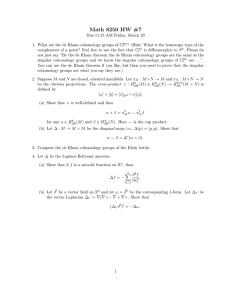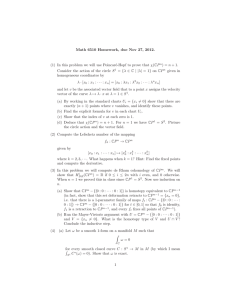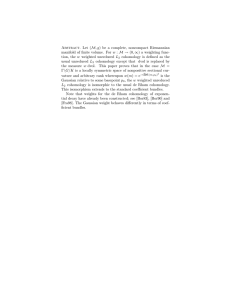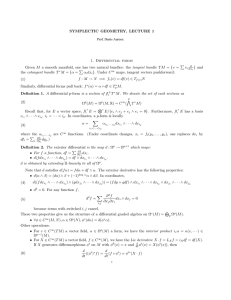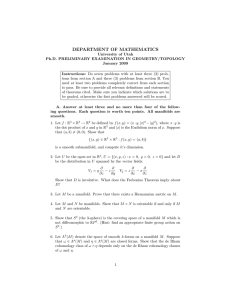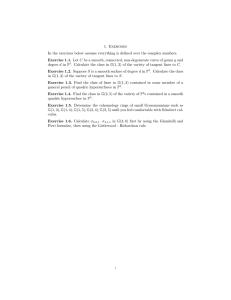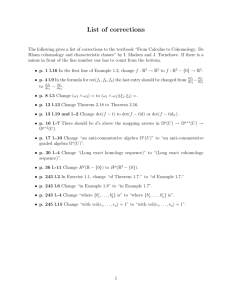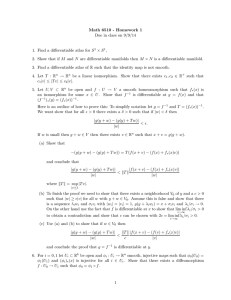Ej -4 P(M) l«, K/ (01) - American Mathematical Society
advertisement
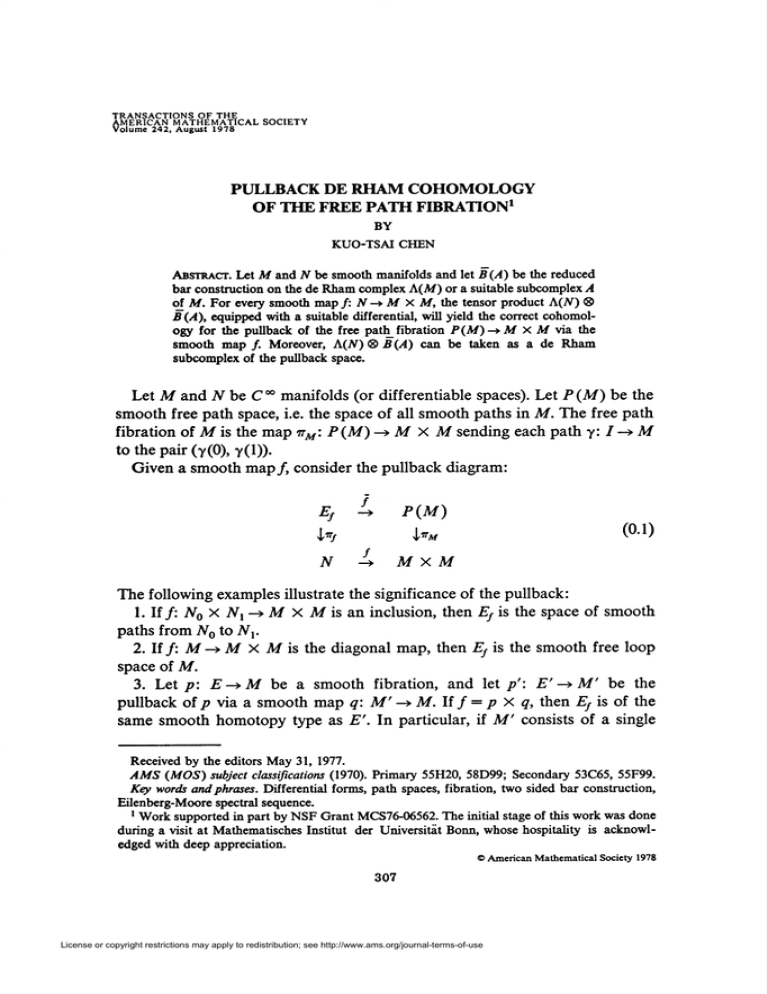
transactions
of the
american mathematical
Volume 242, August 1978
society
PULLBACKDE RHAM COHOMOLOGY
OF THE FREE PATH FIBRATION1
BY
KUO-TSAICHEN
Abstract. Let M and N be smooth manifolds and let B (A) be the reduced
bar construction on the de Rham complex A(M) or a suitable subcomplex A
of M. For every smooth map /: N -* M X M, the tensor product A(N) ®
B(A), equipped with a suitable differential, will yield the correct cohomology for the pullback of the free path_fibration P(M)-*M X M via the
smooth map /. Moreover, A(N)® B(A) can be taken as a de Rham
subcomplex of the pullback space.
Let M and N be C°° manifolds (or differentiable spaces). Let P(M) be the
smooth free path space, i.e. the space of all smooth paths in M. The free path
fibration of M is the map ttm: P(M) -» M X M sending each path y: I -» M
to the pair (y(0), y(l)).
Given a smooth map/, consider the pullback diagram:
Ej -4
l«,
N
P(M)
K/
(01)
-4 M X M
The following examples illustrate the significance of the pullback:
1. If /: N0 X Nx -» M X M is an inclusion, then Ef is the space of smooth
paths from N0 to A^.
2. If /: M -» M X M is the diagonal map, then Ef is the smooth free loop
space of M.
3. Let p: E-*M be a smooth fibration, and let /?': E' -> M' be the
pullback of p via a smooth map q: M' -» M. If / = p X q, then Ef is of the
same smooth homotopy type as E'. In particular, if M' consists of a single
Received by the editors May 31, 1977.
AMS (MOS) subjectclassifications
(1970).Primary55H20,58D99;Secondary53C65,55F99.
Key words and phrases. Differential forms, path spaces, fibration, two sided bar construction,
Eilenberg-Moore spectral sequence.
1Work supported in part by NSF Grant MCS76-06562.The initial stage of this work was done
during a visit at Mathematisches Institut der Universität Bonn, whose hospitality is acknowledged with deep appreciation.
O American Mathematical Society 1978
307
License or copyright restrictions may apply to redistribution; see http://www.ams.org/journal-terms-of-use
308
K.-T. CHEN
point, the E} is of the same homotopy type as the fiber of the fibration p.
Specialized to the case of / = p X q, our main result states that, under
suitable conditions, there is an isomorphism
TorA(A/)(A(F), A(M')) ~H*(E';
R),
where A denotes the de Rham complex functor. Thus this work provides a de
Rham realization of a theorem of Eilenberg and Moore [4]. Such an isomorphism was considered earlier by Wu [10] in terms of Sullivan's minimal
models and the simplicial category. See also the recent works [5] and [6] of
Gugenheim for a more general frame work using the DASH category.
Assume that M is simply connected. Choose a differential graded subalgebra A of the de Rham complex A(M) such that there is an isomorphism
H (A) == H*(M; R) via integration. Let B(A) be the reduced bar construction, whose differential dg is given by
d¿[wx\
■• - K] - 1<S/ < r (-i)Vwil• • • l^-il^k+il • • • k]
-
2
(- l)'[7vvil • • • \JWi-i\JWiA w,-+1|w,.+2|
• • • |w,].
Here our sign convention differs somewhat from the usual one as found in
[7], and Jw = (— l)degM,_w>
for any homogeneous element w.
Denote by A(N) ®f B(A) the tensor product A(N) ® B(A) equipped with
a differential dj such that
df(v ®[w,|
• • • \wr]) = dv ®[w,|
• • • \wr] + Jv ® dji[wx\ • • • \wr]
-JvAf*(wxX
l)®[w2|-
+ (-l)deêu'deêw>Jv A/*(l
•• \wr]
X w,) ® M
(0.2)
where u' = [wx\ • • • \wr_x]. Then A(N)®fB(A)
is a differential graded
vector space (as a matter of fact, a differential graded algebra). The purpose
of this paper is to prove the next theorem.
Theorem 0.1. Let M and N be C°° manifolds. If M is simply connected and
has finite Betti numbers, then there is an isomorphism
H(A(N) ®j B(A))^H*(Ef, R).
(0.3)
It turns out that Ef is a differentiable space and has a de Rham complex
A(Ej). The differential graded vector space A(N) ®f B(A) can be embedded
in A(Ef) as a subcomplex and the isomorphism (0.3) will be obtained via
integration. Therefore the above theorem is of the de Rham type.
In the extreme case of N = { v0} and fy0 = (x0, xQ),Ej is the smooth loop
space ÜM at x0, and the isomorphism (0.3) becomes
H(B(A))~H*($IM;R),
License or copyright restrictions may apply to redistribution; see http://www.ams.org/journal-terms-of-use
PULLBACK DE RHAM COHOMOLOGY
309
which is a loop space de Rham theorem. (See [3, Theorems 2.3.1 and 4.1.1]
and [5, Proposition 6].) At the other extremity of M = {x0), Theorem 0.1 is
simply the usual de Rham theorem.
The starting point of our proof of Theorem 0.1 is the local validity of the
theorem on A^because of the mentioned loop space de Rham theorem. The
global validity on N is then obtained through a method of spectral sequences
and fine sheaf resolutions. Theorem 0.1 has been announced in [3]. Our
original proof is based on a Weil's method of pairing via integration [10].
Remark. In the category of topological spaces and under very mild
conditions, the cohomology of a Serre fibration can be determined through a
construction using minimal models. (See [11, Chapter 20].) In comparison
with the above result, Theorem 0.1 is more restrictive but relates directly to
analysis through integration.
§1 contains some direct applications of Theorem 0.1 to the case of M =
S". In §2, the complex A(N) ®f B(A) is realized as a subcomplex of the de
Rham complex A(F^) in order to make integration possible. The isomorphism
(0.3) is obtained by pairing terms of certain spe£tral sequences on Ex and E2
levels. In §3, a spectral sequence for A(N) ®fB(A) and a related fine sheaf
resolution are discussed briefly. In §§4 and 5, we set up geometrically another
fine sheaf resolution. The proof of Theorem 0.1 is completed in §6 by
comparing the two resolutions.
Let C„ denote the normalized smooth cubical chain complex functor (on
the category of differentiable spaces). The degeneracy will occur on the last
coordinate. Let H+ (resp. H*) denote the smooth homology (resp. cohomology) functor. Let H%R = HA denote the de Rham cohomology functor. We
shall use [ —] to denote a coset, which is often a homology or cohomology
class. We shall work with the real number field.
1. Some applications. Equip the tensor product A(N)®B(A)
fibration g such that
with a
3f (A(AT)® B(A)) = 2 A?(7V)® B (A).
q>p
Then A(N) ®f B(A) becomes a filtered differential graded vector space with
an associated spectral sequence (S',', dr}r>0. We have
S'x"= A"(N) ® H(B(A))
(1.2)
and, owing to Lemma 3.1,
S? = H¿R(N)®H(B(A)).
(1.3)
It follows from (1.3) that, in computing H(A(N) ®y B (A)), we may replace
A(N) by a subcomplex L satisfying the following conditions:
(a) The inclusion induces an isomorphism H(L) <=*H%R(N).
License or copyright restrictions may apply to redistribution; see http://www.ams.org/journal-terms-of-use
K.-T. CHEN
310
(b) The complexL is closed under the A X A-action, i.e. L Af*(A X A) c
L.
Consider the case of M = S", n > 1. Choose A to be the 2-dimensional
subalgebra of A(S") generated by J and w £ An(S") such that js*w = 1.
Then the reduced bar construction B (A) has a trivial differential and a basis
ius)s>o with "o = I ]. "i = M> «2 = M*1]»• • • and deê "j = (" - O*- Set
m, = 0 for s < 0. According to (0.2), we have dj(\ ® us) = W ® us_x where
W = f*(-wX 1 + 1 X w).
If /: {0} -» S" X S"1 is the point map given by /(0) = (x0, x0), then
F7 = fiS". It follows from Example 2.3.1 and Theorem 4.1.1 [3] that there is
an isomorphism
H(B(A)) - B(A) ^H*(2S"; R)
so that {us}s>0 represent a basis for H*(QS"; R).
Example 1. If N0 and Nx are submanifolds of S " of positive codimension
and if/: NQX Nx -» S" X S" is the inclusion, then W = 0 so that the real
cohomology of the differentiable space of smooth paths from N0 to A^jin S"
is isomorphic to the tensor product
H*(N0; R) ® H*(NX;R) ® H*(QS"; R).
Example 2. If/: S" -» S" X S" is the diagonal map, thenf*(w X 1) = f*(\
X w) = w and W = 0 so that the real free loop space cohomology of S" is
isomorphic to the tensor product H*(S"; R) ® H*(QS"; R). (D. Sullivan [8]
has provided a general algorithm for the computation of the rational free loop
space cohomology. See also [9].)
Example 3. If/: S" -» S" X S" is given by x h» (x, - x), then W= -w
+ (— 1)V. When n is even, then W = 0, and we are in the same situation as
in the last example. When n is odd,_then W = —2w. Instead of A(S")
®j B(A), consider the complex (A ® B(A), df], which has a basis consisting
of 1 X us, w X us, s>0,
with ^(1 ® us) = - 2w ® us_x and df(w ® us) = 0.
Thus H*(Ef; R) = R.
Example 4. In the general case, there is a short exact sequence of differential preserving graded maps
0-> A(7V)® R-> A(N) ® B (A)-+ A(N) ® B (A) ->0
where the third arrow is given by v ® us y-*v X us_x. The resulting long
exact sequence is
... -» Hq (N; R) -> Hq (Ef; R)
t
-+Hq-"+l(Ef;R)-*Hq+1(N;R)^>....
In particular, if p: E -» S" is a smooth fibration, then, for
f = pXq:E
X {0}->Sn X S",
License or copyright restrictions may apply to redistribution; see http://www.ams.org/journal-terms-of-use
(1.4)
311
PULLBACKDE RHAM COHOMOLOGY
we may replace, in the above long exact sequence, N by E and E} by the fiber
F. Thus (1.4) generalizes Wang's exact sequence over R.
2. A pairing by integration. We_are going to equip Ef with a differentiable
structure and to realize A(N) ®f B(A) as a subcomplex of A(Ef). Throughout
this paper, U will denote a convex set, by which we mean an «-dimensional
convex subset of R", where n is finite but arbitrary. See [3] for a more
detailed account of the material in this section.
A map a: t/-> P(Af) is called a plot of P(M) if the associated map <>„:
I X U-> M given by (t, Ç) h> a(|)(0 is smooth. A p-form u on P(M) is
defined to be a rule that associates to each plot a of P(M) a/?-form ua on U
such that, if 9: U' -» U is a C00 map of convex sets, then ua9 = 6*ua. (The
dimensions of U and Í7' need not be the same.) Thus there is a de Rham
complex A(F(Af)).
By a plot of a C00 manifold N, we mean a smooth map of the type U->M.
A plot of Ef is defined to be a map <£:U->Ej such that the maps ir^ and/<>
are plots of N and P(M) respectively. There are de Rham complexes A(N)
and A(Ef) defined through plots. The former coincides with the usual de
Rham complex on AT.The map tt} induces a differential graded map mf:
A(N)-» A(Ej) such that, for every plot <pof Ef, (tfv)^ = v„,. Similarly the
map/induces a differential graded map/*: A(P(M)) -» A(F^). Let
A(N) ®fB(A) -» A(Ef)
(2.1)
be the differential graded map given by v ® [wx\ • • • \wr] |-> irfv A
f*fwx • • • wr, where fwx • • • wr is a form on P(M) called an iterated
integral. (It follows from [3, Theorem 4.2.1] that the map (2.1) is injective.)
By a (smooth) «-cube of Ef, we mean a plot of the type <£:I" -> Ef. The
boundary of <bis 3<|>
= 2i<l<n(- 1)'(A°4>
- V*). where V» e = 0, 1, 1 < i <
n, are the face operators.
If u is a/?-form on E}, define the integral f^u such that f^u = //..t^, which
is taken to be 0 when/? =£ n. Let
A(7V)®j B (A) X C,(Ef) -> R
(2.2)
be the pairing given by <ü ® [w,| • • • |wr], <i>>
= f<,(rfv Af*Jwx • • • wr).
Since the map (2.1) is differential graded, the above pairing induces a map
H (Ai/Y) ®f B (A)) -* H*(Ef; R ).
The remainder of this work will be devoted to a proof of the fact that, under
the hypothesis of Theorem 0.1, the above map becomes an isomorphism.
3. A sheaf resolution. The next lemma can be proved in a routine way.
Lemma 3.1. For the spectral sequence {5/, dr) associated to A(N) ®fB(A),
License or copyright restrictions may apply to redistribution; see http://www.ams.org/journal-terms-of-use
K.-T. CHEN
312
the differential
dx. S[" = A"(N) ® h(b(A))
-> A^+,(7V)® H(B (A)) = S'xp+l
is given by v® [z] -> dv ® [z].
Corollary.
IfNis
connected, then
S? = R® H[B(A)) c Si0.
(3.1)
Let V be an open set of N. Regard tt~xV as the pullback space of the
restricted map f\V: V->MXM.
Denote by (S^(V),dr) the_ spectral
sequence of the filtered differential graded vector space A(V) ®^yB(A). For
p > 0, let <B'Pbe the sheaf of graded vector spaces (over N) such that
(&>p(V)= S[»(V) a A"(V) ® H(B(A)).
Define the sheaf ©'-' such that <S'~\V) - S¿°(V). Then ©'*,/? > 0, can be
taken as the sheaf of germs of H(B (A))-valued p-forms on N, and the
exterior differential d: <5'p—>©'*+1 is induced by the spectral sequence
differential dx according to Lemma 3.1. The sequence of sheaves
O-»©'-1-»©'0-^ ...
4- ©''4. ...
(3.2)
is a fine resolution of the sheaf
<S'-l~m®H(B(A))
(3.3)
where 91denotes the constant sheaf. We have, for/? > 0,
H" (N, S'"1) -Ä* (S'*(N), d) = S^.
(3.4)
4. A base-point-free Serre spectral sequence. Hereafter we shall write
E = Ej and it = <ns.Let a be a nondegenerate (smooth) /?-cube of N. A
(P + ?)-cube 5 of E is called a îT-fibered ç-cube over a if there is a
commutative diagram:
/' X I"
4
¿projection
/'
F
\,ir
4
v*-U
TV
For 1 < / < q, e = 0, 1, each face Ap"+iöis a Tr-fibered (q — l)-cube over a.
Set
305= 2
(-D'+,(a^,5-a;+/5).
The totality of 77-fiberedcubes over a and the boundary operator 30 give rise
to a normalized chain complex C(o-)„ = {C(a)q), whose homology will be
denoted by H(o)+ = {//(o-)^}. A cycle of C(o)+ will be called a 77-fibered
cycle over a.
License or copyright restrictions may apply to redistribution; see http://www.ams.org/journal-terms-of-use
PULLBACKDE RHAM COHOMOLOGY
313
The normalized smooth cubical chain complex C^(E) has an ascending
filtration g such that ^pC^(E) has a basis represented by all nondegenerate
77-fibered cubes of E over a nondegenerate cube of N of degree < p. The
resulting spectral sequence {Sr, 3r}r>0 will be called the Serre spectral
sequence of the pullback it. Then
# -11*00,
(4-2)
summing over all nondegenerate/?-cubes a of N.
If z is a 77-fiberedç-cycle over a, then, for 1 </</?,
e = 0, 1, \fz is either
a 77-fibered <7-cycleover \'a or a 77-fibered chain over some nondegenerate
cube of degree < /?. Therefore the differential 8 ' is given by
a'W-Si-i)'*1^]
(4-3)
summing over all (i, e) with 1 < i < q, e = 0, 1, and \'a nondegenerate.
Define a C00 manifold A/ to be smoothly contractible toj>0 if there exists a
smooth homotopy to v0 E N
h:IXN^N
(4.4)
such that h(0,y) = y and A(l,^) = y0, Vj>E A. The next lemma is straightforward.
Lemma 4.1. If N is smoothly contractible toy0, then there exists a commutative diagram
I XE
-4
j.1 X ir
I XN
E
Xw
4
N
such that h is a smooth contraction as in (4.4) and h is a smooth map with
h(0,y)=y,\/yEE.
Regard the trivial map Ey¡¡= 77""'{^o}-> {Jo} as a pullback of the free
path fibration so that there is an associated Serre spectral sequence
{Sr(y0),Br}. Then, for r> 1,
S¿(y0) = H,(Eyo)
(4-5)
and S;(y0) = 0 for/? > 0.
Lemma 4.2. If N is smoothly contractible to y0, then the inclusion C^(Ey^ c
Cm(E) induces isomorphisms S2(y0) =* S2, /? > 0.
Proof. Let e: E^>Eyo be given by ë(y) = h(l,y).
Eyo-* E —>Ey¡¡induces an identity composite map
Sp2(y0)^Sp2-»Sp2(y0),
p>0.
License or copyright restrictions may apply to redistribution; see http://www.ams.org/journal-terms-of-use
The composite map
314
K.-T. CHEN
On the other hand, the composite map h~x:E->Eyo->E induces
spl-*spl(y0)^sp\
p>0,
given by [z] \-> [Auz], where z is a 77-fibered ç-cycle over a nondegenerate
/?-cube a of N, and [z] E H(a)q c 5J,1.Observe that hx+z is a linear combination of cubes of the type 5hx, which is a 77-fibered(/? + ç)-cube over the
0-cube aty0. Thus [hx+z]= 0 for/? > 0.
Let Da be the composite map
ixipX¥ ixnXn.
If a is a 77-fiberedç-cube over a, define Do to be the composite map
/x(/'x/*)145/xf4f,
which is a 77-fiberedç-cube over the (/? + l)-cube Da. Then Z) induces maps
H(a)q -» H(Do)q, which give rise to maps
DliS$-*S£+u
p>0,
such that
0,¿í'
+ /31a1)[z]=[«1,z]-[z].
Hence the lemma is proved.
Corollary.
sequence
Under the same hypothesis as the lemma, there are a long exact
...->$;_»->S¿^S2-*0
(4.6)
and an isomorphism
s¿(y0)~s2
(4.7)
inducedby the inclusionEygc E.
5. The singular cohomologicalsheaf resolution. For an open set V of N, the
normalized smooth cubical chain complex C^(ir~lV) is filtered with an
associated Serre spectral sequence (Sr(V), ar)r>0 if t7_1F is taken as the
pullback space of the restricted map/| V. Morever,
Sp\(V)=JlH(a)q
summing over all nondegenerate/?-cubes a of V.
For/? > 0, let ©^ be the presheaf of graded vector spaces over N such that
<3p(V) = {<SP(V)q) with &(V)q = Homz(Sp\(V), R). The spectral
sequence differential 3 ' induces presheaf maps
8:&-*&+\
/?>0.
(5.1)
Denote by ©-1 the presheaf such that ©_,(F)9 = Homz(S^(K). R). Since
License or copyright restrictions may apply to redistribution; see http://www.ams.org/journal-terms-of-use
pullback
de rham
315
COHOMOLOGY
Soq(V) is a quotient of Soq(V), there is a monomorphism
©-1-*©0.
(5.2)
Each presheaf &, p > 0, is fine. In fact, let {U¡}ie%ibe a locally finite
open covering of N and let ju be a choice function which assigns to each
nondegenerate cube a of A an element fi(a) of the index set 5ß such that
o(0) E UKo).Given i E Sß, define an endomorphism e¡ of ©^ such that, for
every open set V of N, e¡(V) is the projection
&(V) =IlHomz(/y(o-)„ i?)-*II'Homz(^(a), R) c @>(K),
where the second product II' runs over those nondegenerate /?-cubes a of V
with ju(o-)= i. Then 2e, is the identity presheaf map of ©*, and & is fine for
/? > 0. Let ©* denote the completion of ©p,/? > —1. For/? > 0, each ©^ is a
fine sheaf.
The presheaf maps (5.1) and (5.2) give rise to a sequence
0^©->_»©°4 ••• 4@*4 ....
(5.3)
Since A is a manifold, every point y0 of N has an arbitrarily small neighborhood V smoothly contractible to y0. It follows from (4.6) that the above
sequence of presheaves completes to a sequence of sheaves
0^©-i^©°4 ... 4 ©"4...,
(5.4)
which is a fine resolution of the sheaf @" '.
Since N is paracompact, #*(@*(A), 5) « H"(ê*(N), 8), p > 0. Recall
that @*(A) = Uomz(S2, R). The fine resolution (5.4)yields
H> (N, ê- ') » Homz(s/, R ).
(5.5)
6. The conclusionof the proof.
Lemma 6.1. The pairing (2.2) respects the filtration.
Proof. Let v be a /»'-form on N, and let 5 be a 77-fiberedç-cube over a
/?-cube a of A with /? < /?'. The /?'-form o*ü on Ip must vanish. The
commutative diagram (4.1) implies that ö*ir*v = 0. Hence
(ir*vAf*fwx' " wr>5)=fp
a*lir*vAf*fwx • • • wr\=0.
In abbreviation,write fF = ÏY(A(N) ® B(A)) and Sp = %PCJ(E).Recall
that if 3' = {«e 3?: ¿/ME fF"*"1},
then S[p = ^"/(dß^ + %"+1)and
Si0 = {« E S°: dfu E S2}/ (4S° + 31)Similarly,if 3, = [c E S,; c E S,_,}, then S,1= 8,/(3S, + 3,-i) a11«1
502= 8o/33i.
The pairing (2.2) induces pairings
License or copyright restrictions may apply to redistribution; see http://www.ams.org/journal-terms-of-use
316
K.-T. CHEN
S¡" X Si -* R,
p>0,
(6.1)
and
S? X Si -* R.
(6.2)
The pairing (6.1) is given by <[w],[c]> = fcxu, where u E Sp, c E Qp and x is
the map (2.1). Moreover, if/? > 0 and w' E 3P~\ then
(*[*],[€])
-<[«'], a»[c]>.
(6.3)
If V is an open set of N, then, corresponding to (6.1) and (6.2), there are
pairings
S[" (V)XSP1(V)->R,
p>0,
(6. la)
and
S?(V)XS¿(V)^R,
(6.2a)
which induce presheaf maps
©v _>©*,
^ > o,
(6.4)
and
©'-i_*©-i.
(6.5)
Lemma 6.2. If V is smooth contractible to y0 E V, then the pairing (6.2a)
induces an isomorphism @'~'(F) =* <S~l(V).
Proof. Let fy0 = (x', x"). We identify Ey<¡with the differentiable space
P(M; x',x") of all smooth paths from x' to x" in M. According to the
isomorphisms (3.1), (4.5) and (4.7), the pairing (6.2a) can be taken as the
pairing
H (B (A)) X Hj(P (M; x', x")) -> R,
(6.6)
which is induced by the pairing
B (A) X C+(P (M; x', x")) -* R
given by <[w,| • • • \wr], c> = /Jw,
(6.7)
■ - • wr.
Let y be a smooth path from x' to x". Consider the map g: I -> M X M
given by t h» (x', y(t)). Let 77Ä:Eg -> I be the associated pullback from the
path fibration nM. Then C^(Eg) has an associated Serre spectral sequence
{ Tr, 3r}. Corresponding to the pairing (2.2), there is a pairing
A(I)®gB(A)xC¿Eg)->R.
In the place of the pairing (6.2), we now have the pairing
H{B(A))xTi^R.
(6.8)
The respective fibers of the pullback 77gabove the points 0 and 1 are
License or copyright restrictions may apply to redistribution; see http://www.ams.org/journal-terms-of-use
PULLBACK DE RHAM COHOMOLOGY
317
precisely P(M; x', x') and P(M; x', x"). According to (4.7), there are isomorphisms H*(P(M; x', x')) « F02« H+(P(M; x', x")). This implies that
the pairing (6.6) can be, in turn, taken as the pairing
H (B (A)) X H+(P (M; x', x')) -^ R
which is induced by a pairing similar to (6.7). Using Theorem 2.3.1 of [3] (see
also [5, Proposition 6]), we obtain an isomorphism
H(B(A)) ^H*(P(M;
x', x'); R).
Hence the lemma is proved.
Proof of Theorem 0.1. There is a commutative diagram of sheaves
0->
©'-'
_>->
@v
i
-»...
i
o-» ©-> _>->
é" ->...
where the first row is the fine sheaf resolution (3.2), the second row is the fine
sheaf resolution (5.4), and the vertical maps are induced by (6.4) and (6.5).
According to Lemma 6.2, the first vertical map is a sheaf isomorphism so that
H"(N, S'-1) « Hp(N, S-1),/? > 0. From (3.4) and (5.5), we obtain S? «
Homz(Sp, R). Thus the pairing (2.2) induces a spectral sequence pairing
s; X Sr->R,
which is nondegenerate for r > 2. Since both spectral sequences (5"/, dr) and
[Sr, 3r} converge, the pairing (2.2) induces a nondegenerate pairing
H(A(N)®fB(A))
X H¿Ef)^R.
Hence the theorem is proved.
Bibliography
1. K. T. Chen, Iterated integrals of differential forms and loop space homology, Ann. of Math.
97 (1973),217-246.
2._,
Reduced bar construction on de Rham complexes, Algebra, Topology and Category
Theory, A Collection of Papers in Honor of Samuel Eilenberg, Academic Press, London, 1976,
pp. 19-32.
3_,
Iteratedpath integrals,Bull. Amer. Math. Soc. 83 (1977),831-879.
4. S. Eilenberg and J. C. Moore, Homologyandfibrations. I, Comment. Math. Helv. 40 (1966),
199-236.
5. V. K. A. M. Gugenheim, On the multiplying structure of the de Rham theory, J. Differential
Geometry11 (1976),309-314.
6. _,
On the multiplicative structure of the de Rham cohomology of induced fibrations
(preprint).
7. L. Smith, Homological algebra and the Eilenberg-Moore spectral sequence, Trans. Amer.
Math. Soc.129(1967),58-93.
License or copyright restrictions may apply to redistribution; see http://www.ams.org/journal-terms-of-use
318
K.-T. CHEN
8. D. Sullivan, Differentialforms and topologyof manifolds, Conferences on Manifolds, Tokyo,
1973.
9._,
Infinitesimal computationsin topology(preprint).
10.W. T. Wu, Theoryof I*-functor in algebraic topology,Sei. Sínica 18 (1975),464-482.
U.S. Halperin, Lectures on minimal models. Université des Sciences et Techniques de Lille. I,
1977.
Department of Mathematics, University of Illinois, Urbana, Illinois 61801
License or copyright restrictions may apply to redistribution; see http://www.ams.org/journal-terms-of-use
